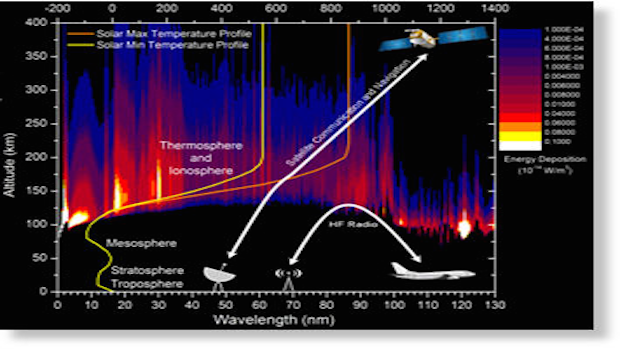
Solar Extreme Ultraviolet (EUV) is solar radiation that covers the wavelengths 10 – 120 nm of the electromagnetic spectrum. It is highly energetic and it is absorbed in the upper atmosphere, which not only heats the upper atmosphere but also ionizes it, creating the ionosphere. Solar EUV radiation changes by a factor of ten over the course of a typical solar cycle. This variability produces similar variations in the ionosphere and upper atmosphere. Solar EUV variations are one of the three primary drivers of ionospheric variability.
Solar Extreme-Ultraviolet (EUV) radiation originates in the corona and chromosphere of the Sun’s atmosphere. The solar EUV spectrum, between 1 and 120 nm, is dominated by spectral lines from hydrogen (H), helium (He), oxygen (O), sodium (Na), magnesium (Mg), silicon (Si), and iron (Fe). The EUV photons reach Earth and are completely absorbed in the upper atmosphere above 80 km. The thermosphere of the earth, 80 to 600 km in altitude, is heated predominantly by solar EUV radiation. The EUV photons also ionize the atmosphere creating electrons, which form the ionosphere. Solar EUV irradiance varies by as much as an order of magnitude on time scales of minutes to hours (solar flares), days to months (solar rotation), and years to decades (solar cycle). The highly varying EUV radiation causes the thermosphere and ionosphere to vary over similar magnitudes and time scales.
Because solar EUV radiation is absorbed by the upper atmosphere it is impossible to measure from the ground. Thus, measurements must be made from rockets and satellites. It is difficult to build and maintain sensors that can measure the solar EUV radiation so for many years people relied on proxies for solar EUV such as the Sunspot Number or the F10.7 cm radio flux.
Figure: R. Viereck